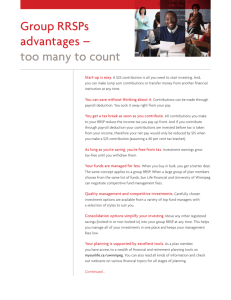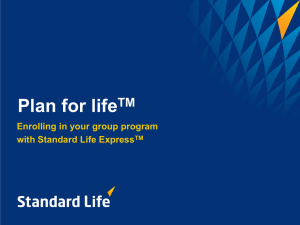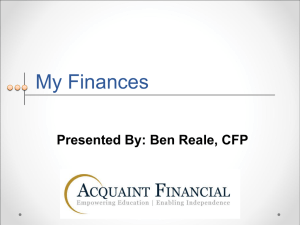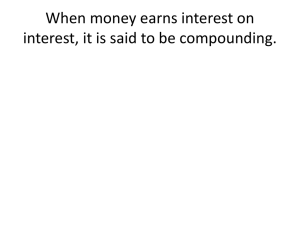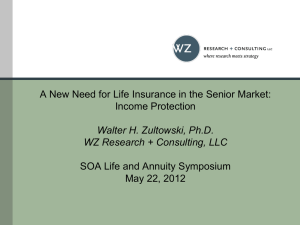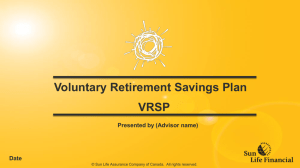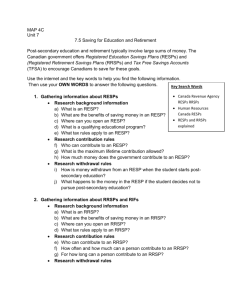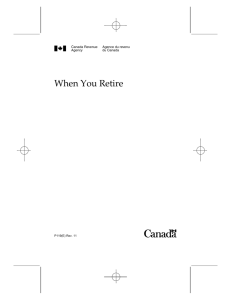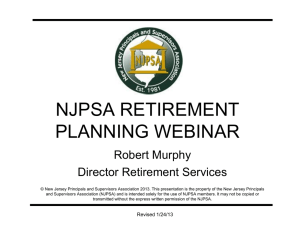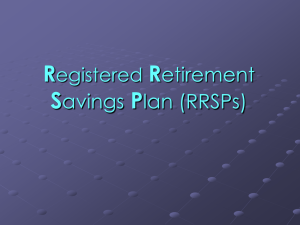Presented - Financial Management Institute of Canada
advertisement
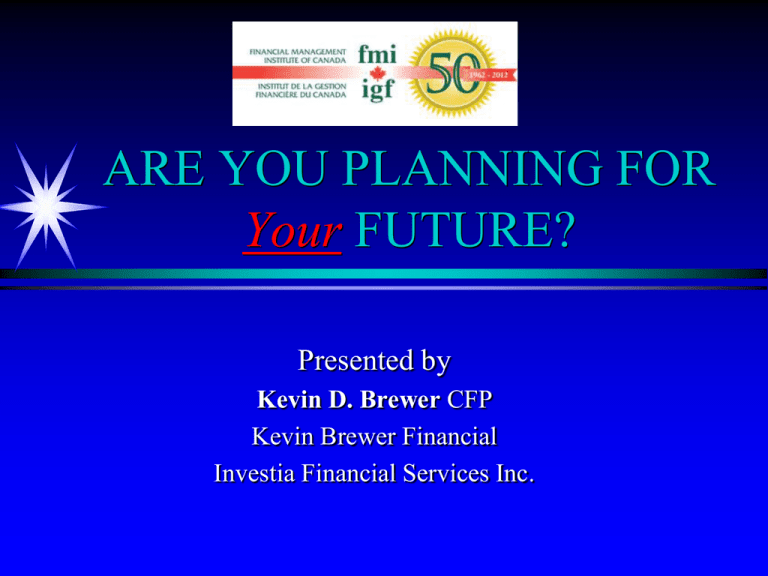
ARE YOU PLANNING FOR Your FUTURE? Presented by Kevin D. Brewer CFP Kevin Brewer Financial Investia Financial Services Inc. Kevin D. Brewer CFP Suite 301, 500 Beaverbrook Court Fredericton, NB E3B 5X4 506-454-4478 Kevin@kevinbrewerfinancial.com www.kevinbrewerfinancial.com * Certified Financial Planner * Mutual fund and Life/Disability Insurance licensed * 20+ years industry experience * Specializes in Retirement and Estate Planning * Trained in CRP (Comprehensive Retirement Planning) software. * Independent representation providing broker services of financial products * Hobbies/Passions/Community include boating, grandkids, past President JoyFm radio, Volunteer Ambassador Fredericton Food Bank, Volunteer advisory board member of Alzheimers Society NB, volunteer Salvation Army. Today’s purpose… No Sales guarantee I will not talk about specific products (except for one) Free service to groups and organizations Raise awareness of sound financial practices Today’s agenda… but not in this order Tax brackets Retirement Allowance Taking CPP New CPP rules Pension integration OAS claw back Pension vs. Lira Pension at death Estate Planning ideas Stock Markets Investments Your questions What Are Your Goals? •Retire early •Retire comfortably •Pay less income tax •Preserve my Estate A Solid Foundation Rules of Cash Management * Spend Less Than You Earn * Read TWB - David Chilton * The dreaded B word * Pool anyone? * Pay Yourself First Rules of Debt Management * Spend Less Than You Earn * Do not borrow to pay debt (except in some cases …) * One at a time * Is there good debt? * Never be late. It’s Patrick! Why Insure? Provides protection against loss … * Loss of life (life insurance for dependents and/or CRA) Term, UL, Whole Life * Loss of income (disability insurance) * Loss of independence (Long Term Care and Critical Illness) * Leave Inheritance to family/charity * Last expenses • Why does insurance planning come before investment planning? The Reality . . . 1/3 People will be disabled for more than 90 days before they turn 65. 1/ 2.8 People will develop a critical illness The “sandwich generation” deals with the care needs on both ends of the life spectrum. … most everybody has life insurance but few are prepared for the sickness or disability. Running with the Bear! Market Volatility Today’s market Past experience with market fluctuations Good or bad time to buy?? What to buy?? Best time I’ve seen or worse?? What about the headlines?? July 9th, 1979 DOW JONES = 852.99 DOW JONES 10yrs later = 2,487.86 $1,000 invested in the Dow Jones on the day this issue hit the stands would have been worth $2,917 ten years later. (almost tripling in 10 years) July 9th, 1979 December 3rd, 1984 DOW JONES = 1,182.42 DOW JONES 10yrs later = 3,745.62 $1,000 invested in the Dow Jones on the day this issue hit the stands would have been worth $3,168 ten years later. (more than tripling in 10 years) December 3rd, 1984 November 2nd, 1987 DOW JONES = 2,014.09 DOW JONES 10yrs later = 7,442.08 $1,000 invested in the Dow Jones on the day this issue hit the stands would have been worth $3,695 ten years later. (more than tripling in 10 years) November 2nd, 1987 THE WEEK THAT CHANGED AMERICAN CAPITALISM Wall St Journal, Sept 20/21, 2008 A Rough Start to 2009 Nobody Forecast This! January 1, 2009 to March 2009 Trough -15.5 -24.3 -20.4 -19.0 Nobody Forecast This! March 9, 2009 Trough to May 31 2010 55.4% 61.0% 47.7% 39.0% Local Currency Source: Bloomberg Words of Wisdom JOHN KENNETH GALBRAITH Economist “We have two classes of forecasters: Those who don't know – and those who don't know they don't know” Three Places to Invest Low Medium Variability Variability High Variability Interest Interest / Dividends Capital Gains .25 – 2.5 % 2.5 -5 % 5–?% Pros and Cons Capital gains and Dividends received preferred tax treatment (only on non-reg investments). Minimum 5 year period required for equity investments (7-10 would be better) Real risk tolerance not known until something bad happens Financial planner’s rule of risk = 100 - age Traditional Wisdom Says: Time not Timing determines Success. Asset Allocation with systematic rebalancing is the key to strong and steady performance with reduced risk. “ BUY LOW – SELL HIGH – REPEAT” Kevin Brewer …What is the single largest expense we, as Canadians will face in our lifetimes? TAX! 3 Primary Tax Brackets $11,000 $38,000 $38,000 $76,000 $76,000 – $124,000 15% Fed 9% Prov 22% Fed 12% Prov 26% Fed 12%Prov Approx. 24% Approx. 34% Approx. 38% Can you pay less tax? Tax deductible non-registered investment strategies (use existing cash to purchase…) Income splitting Buy RRSP/RRIF Insurance Borrow to top up allowable RRSP limit (use good debt to pay bad). Borrow X2 Save for your goals tax-free! Retirement Allowance (Severance Pay) Allowed to rolled to an RRSP (direct transfer) $2000 for every year or partial year in which you participated in pension plan prior to and including 1995. Anything above that cannot be rolled directly but may be eligible for RRSP contribution based on personal room. Generally capped to 25 weeks based on final year’s income. Retirement Allowance (New Options) Effective March 31, 2013, management and non union employees in parts 1,11, and 111 will no longer accumulate retirement allowance credits. OPTIONS 1. Obtain a payout in lieu of ret. allowance based on credits accum’td and salary to Retirement Allowance (New Options) Question of the day: Do I take the money now or defer it a few years until I retire? Retirement Allowance (New Options) Example: Joe, age 45, 15 accumulated pension years credit Salary $52,000 ($1000 week) Pay in lieu of retirement allowance = $15,000 Assumption: intent is to work another 15 years Retirement Allowance (New Options) Based on the previous assumption, the investment simply has to outpace the rate of salary increases each year (or the average). Ie: if the salary for this job description only increases by CPI of 2 or 3% each year, the investment portfolio only has Retirement Allowance (New Options) So if you think that investment performance will outpace your salary increase then the choice based on that alone would be to take the money today. However … What if the expectation is that you will move up the ladder to a more senior position in Govt over the years and thus retire with a salary much larger than your present one? What would that increase in salary have to be to offset an investment return of 4%, 5%, or 6%? Retirement Allowance (New Options) $15,000@ 4% return over 15 Yrs = $27,014 $93,648 = $1800.93/wk X 15 wk = $27,014 $15,000 @ 5% return over 15 Yrs = $31,184 $108,104 = $2078.92/wk X 15 wk = $31,184 Other Considerations (New Options) What if you defer the retirement allowance but before you reach your intended retirement age you decide to voluntarily leave your employment ? Other Considerations (New Options) What if you defer the retirement allowance but before you reach your intended retirement age you decide to voluntarily leave your employment ? Under the old rules you would not qualify for the Other Considerations (New Options) Is it better to put this investment in my spouse’s name (Spousal RRSP) for tax purposes? Other Considerations (New Options) Is it better to put this investment in my spouse’s name (Spousal RRSP) for tax purposes? Much of the advantage in doing a spousal RRSP has been negated with the introduction of the new Pension Income Splitting rule. However, it Summary (New Options) This decision is made more difficult because it must be made based on these unknown variables and assumptions: What will be the performance of my investment versus What will be my final salary at retirement (if I Summary (New Options) Bottom line: A Bird In The Hand … Procedures/Paperwork (New Options) For allowances less that $10,000: 1) 2) CRA Letter of Intent Regarding a Deductible Contribution to an RRSP Province of NB Financial Institution Form Forms: Declaration of Intent Form: Financial Institution Information Form Procedures/Paperwork (New Options) For allowances greater than $10,000: 1) 2) Apply to CRA using CRA form T1213 for permission for Province to do a direct transfer to your financial institution of choice. Allow 4-6 weeks for their response. Then provide their response along with the form below to Province Province of NB Financial Institution Form Form: CRA T1213 Procedures/Paperwork (New Options) In the first case (less than $10,000) you are indicating to the Province that you have the room to transfer to an RRSP. In the second case (more than $10,000) proof is required from CRA. IF this is the case, you must submit your request to CRA OAS and the OAS Clawback Amount same for everyone at age 65 = $546.07/mo or $6552.84/year Claw back begins at $70,954 and is depleted at an income of $114,640 If a taxpayer in receipt of OAS benefits has net income in excess of the base amount for that year ($70,954 for 2013) he or she must repay 15% of net income in excess of the base amount. Example: net income = 80,954 then 15% of $10,000 ($80,954-$70,954) or $1500 of OAS must be paid back of the $6552.84 annual payment. Pension Options and death of pensioner Generally offered 5 or 10 year guarantee and… A reduced amount with 50% to surviving spouse or… A reduced amount with 60% to surviving spouse or… A reduced amount with 75% to surviving spouse (reduced to $0 upon death of final spouse) WHAT ABOUT COMMUNTED VALUES vs PENSIONS? * Owner controls investment choices (must have discipline) * Locked-in rules apply limiting maximum annual withdrawal * Locked-in rules broken at death allowing full tax sheltered transfer to remaining spouse * Can be passed to beneficiaries upon death of final spouse but taxes will be owing There is a need for estate planning in these cases My Dear Children… …we love you so much we’ve decided to leave half our wealth to the Canada Revenue Agency Estate Planning Strategies Beneficiary designations Joint ownership Gifting Insurance Trusts Segregated funds Annuity products About WILLs and POAs ... Prevents the courts from making decisions for you. Allows life to carry on for those left behind the way you intended it to. Education Savings Registered Education Savings Plans (RESPs) Government savings program 20% grant on contributions Can withdraw contributions and growth if not used, just have to return grant If used, withdrawn at beneficiary’s Marginal Tax Rate Conclusion Financial planning is complex Your true beliefs have to be taken into consideration Decide what you want to achieve - what’s most important to you and your family Talk to those that are affected by your wishes Planning is a work in progress - it requires ongoing review and modification Types of Financial Plans: * Fee for Service based on complexity of plan required. * No fee but based on assumption that if good work/advice is provided then future business may occur. Fee then paid in form of commission by product manufacturer – not the client. ONE LAST THING In appreciation of your attendance . . . THANK YOU QUESTIONS?
